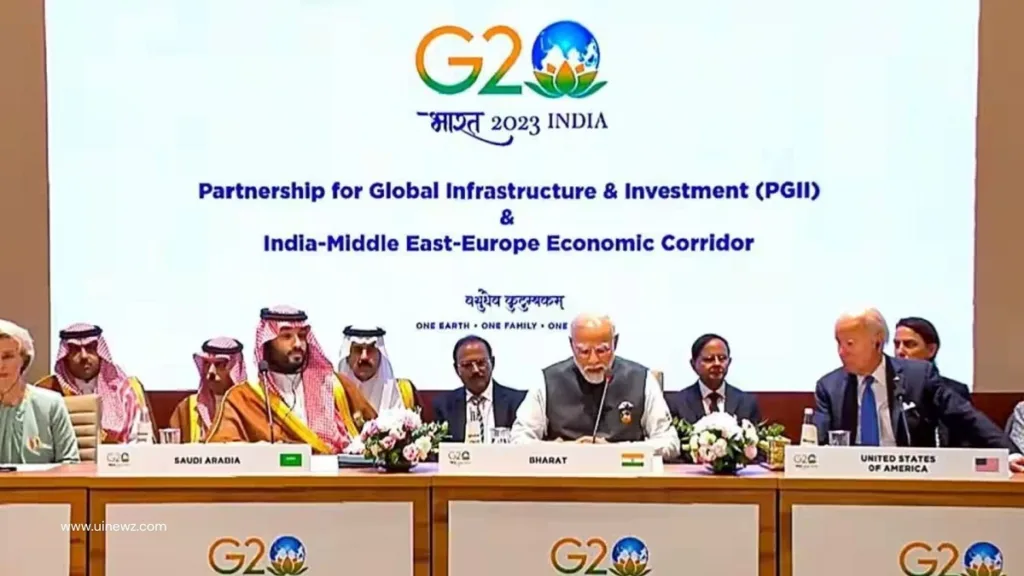During the G20 Summit in New Delhi, government of India, the United States, Saudi Arabia, the European Union (EU), the United Arab Emirates (UAE), France, Germany, and Italy joined forces to establish the India-Middle East-Europe Economic Corridor (IMEC). This bold initiative aims to reshape connectivity and trade between three continents and presents a significant alternative to China’s Belt and Road Initiative (BRI).
IMEC is a vital component of the broader Partnership for Global Infrastructure Investment (PGII), initially introduced during the G7 summit in the UK in June 2021. The PGII seeks to finance infrastructure projects in developing countries by leveraging a combination of public and private investments. IMEC, with its formidable reach and scope, forms the heart of this initiative.
Table of Contents
What is IMEC?
The India-Middle East-Europe Economic Corridor (IMEE-EC) is an infrastructure development project of monumental significance. Its primary objective is to foster connectivity through a comprehensive network encompassing railways, sea lanes, energy cables, and data links. IMEC aims to boost trade, promote clean energy, and stimulate economic growth, all while providing a compelling alternative to China’s BRI.
Key Aspects of IMEC
- Participating Countries: IMEC boasts participation from a formidable group of nations, including India, Saudi Arabia, UAE, France, Germany, Italy, the USA, and the EU. This collaborative effort underscores the project’s global significance and potential impact.
- Objectives: Beyond enhancing connectivity, IMEC’s core objectives include promoting clean energy, facilitating economic growth, and establishing a viable alternative to the BRI, effectively diversifying the global infrastructure landscape.
- Part of PGII: IMEC is intricately tied to the Partnership for Rail and Shipping Corridors within the Global Infrastructure Investment framework. It places a strong emphasis on enhancing global trade and cooperation through the development of critical infrastructure.
Components of the Corridor
IMEC’s infrastructure components are diverse and transformative:
- Railway Lines: The project intends to create high-speed rail links that could make trade between India and Europe up to 40% faster, revolutionizing cross-continental logistics.
- Energy Infrastructure: IMEC will feature electricity cables and a clean hydrogen pipeline, facilitating clean energy trade and bolstering sustainability efforts.
- Digital Connectivity: High-speed data cables will be laid to connect innovative digital ecosystems worldwide, paving the way for new business opportunities and enhancing global data connectivity.
Corridor Segments
IMEC comprises two key segments:
- Eastern Corridor: This segment will connect India to the Arabian Gulf, further strengthening trade and economic ties between the two regions.
- Northern Corridor: Extending from the Arabian Gulf to Europe, this corridor promises to streamline the flow of goods and services between Europe and the Middle East.
Benefits for India
India stands to gain immensely from IMEC:
- Enhanced Food Security: The corridor will improve food security by facilitating the efficient movement of goods.
- Strengthened Regional Supply Chains: IMEC will strengthen regional supply chains, making them more resilient and robust.
- Trade Accessibility: It will boost India’s trade accessibility by providing efficient transportation routes.
- Environmental Considerations: IMEC will contribute to environmental sustainability by reducing greenhouse gas emissions.
- Economic Cohesion: The corridor will stimulate economic cohesion among participating countries.
- Job Creation: The project is expected to generate a significant number of jobs across various sectors.
Geographical Advantage
IMEC strategically positions India along a pivotal trade route that spans Southeast Asia, the Gulf, West Asia, and Europe. This positioning will play a pivotal role in shaping global commerce, digital communication, and energy networks, offering India a prominent role on the world stage.
In conclusion, the India-Middle East-Europe Economic Corridor (IMEC) represents a groundbreaking initiative that holds the potential to reshape global connectivity and trade dynamics. With its extensive infrastructure network and collaborative spirit, IMEC stands as a formidable alternative to China’s BRI, offering new possibilities for economic growth, sustainability, and international cooperation on an unprecedented scale.
